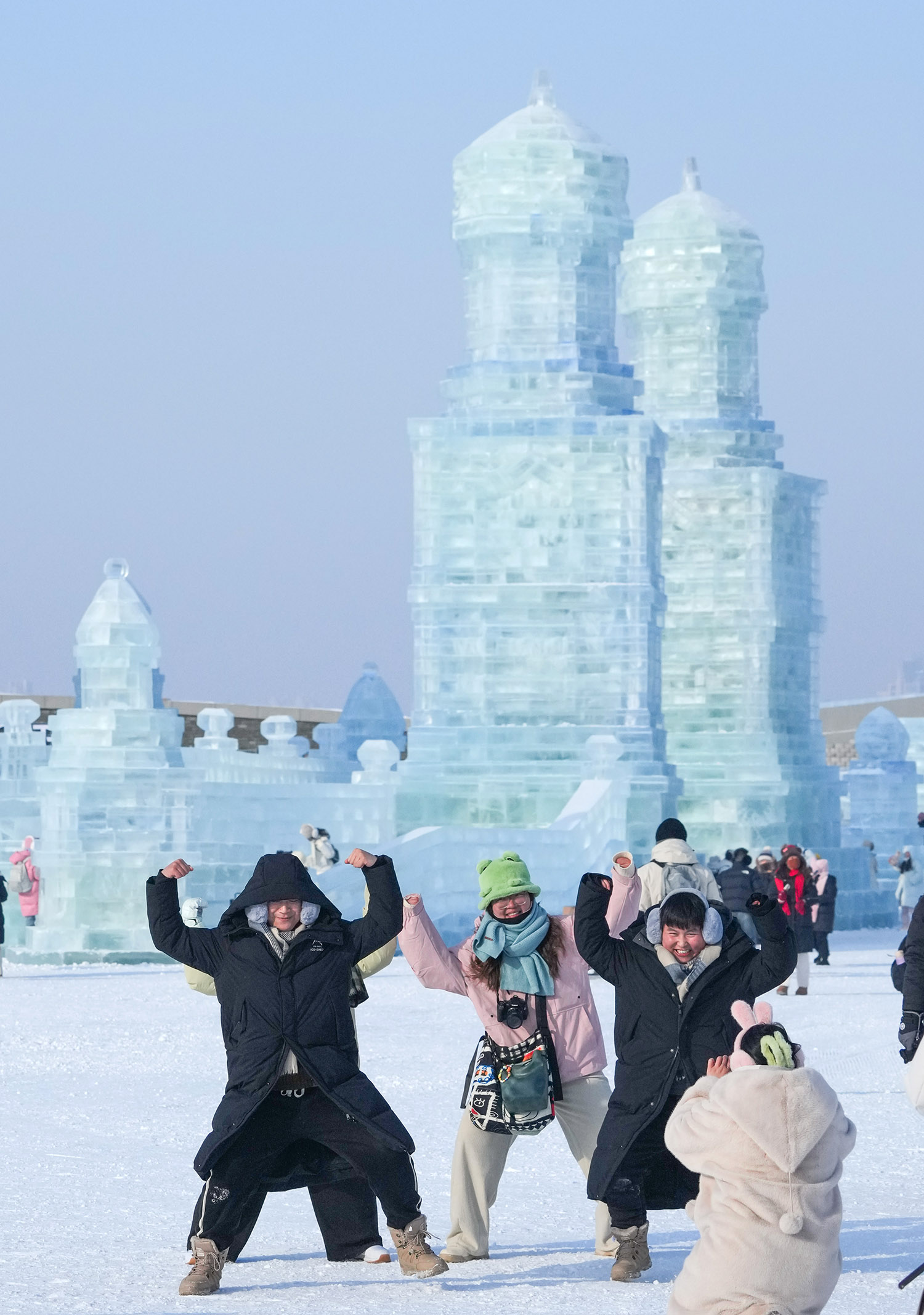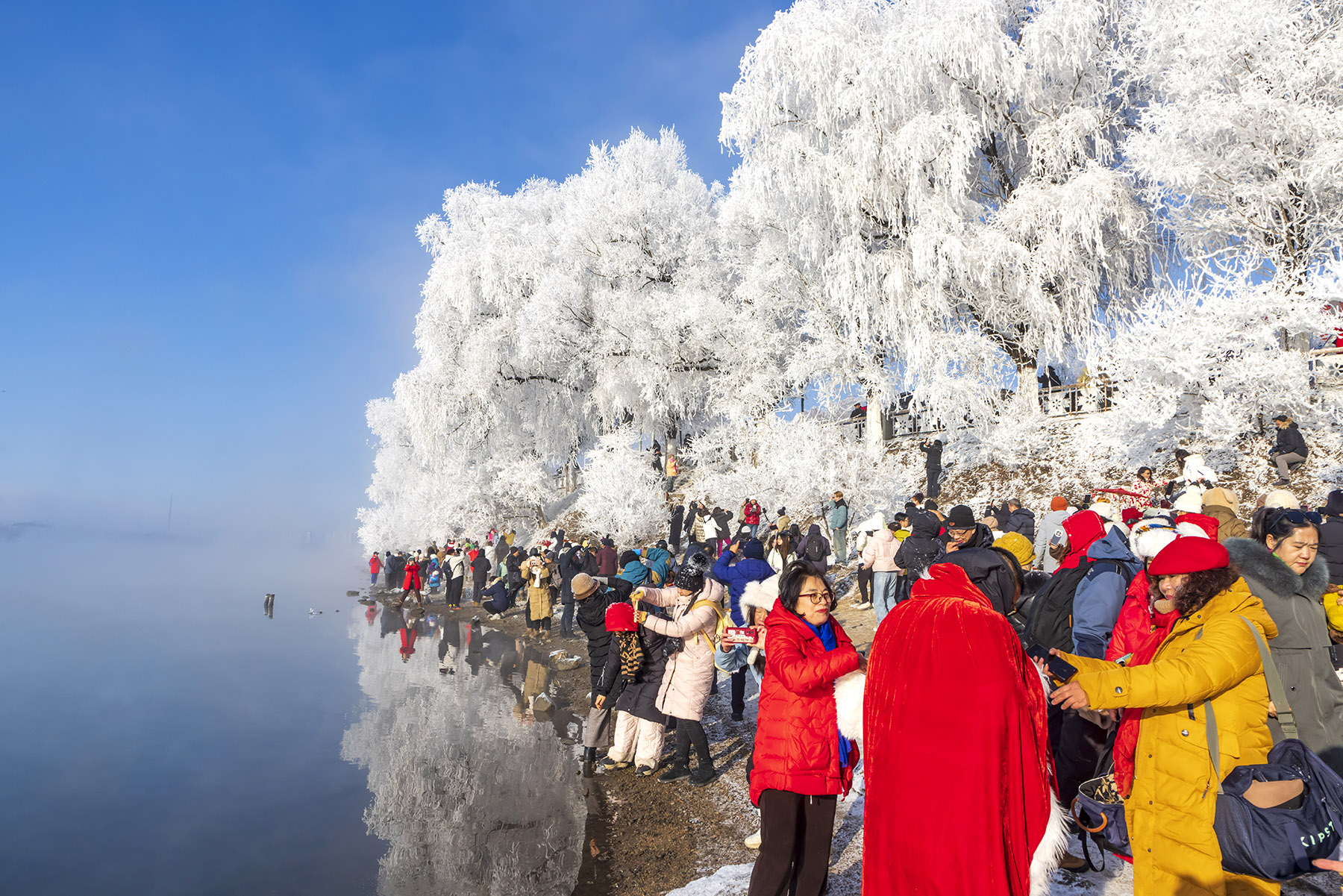Visitor rush to Harbin for the ice and snow festival reflects growing popularity of cold-weather leisure activities

Hou Wei has been enjoying the winter chill since he arrived in Harbin, capital of Heilongjiang province, late last month. He has been delighted by the many delicately carved ice sculptures at the Harbin Ice-Snow World, and the distinctive Russian-style architecture of Central Street.
“I’ve been wanting to come to Harbin for a long time,” said Hou, who is from Hangzhou, Zhejiang province.
The man in his 30s spent the New Year’s Day holiday in the northeastern city. It is his first visit to the province.
“The ice sculptures are stunning and the cold isn’t as bad as I imagined; -20 C is manageable as long as you’re properly dressed,” he said. “That first breath of cold air as you step out from the warmth is something I find somehow oddly familiar.”
He skied, sampled local dishes from iron pot stew to grilled skewers, and has taken a hot bath followed by the traditional exfoliating scrub that is a popular winter experience.
The trip has been fulfilling. “The bright, dry, brisk winter of the northern regions is special, constantly reminding you that you’re in Northeast China,” he said.
Hou is one of an increasing number of travelers who are drawn to the fun of snow and ice.
Dai Bin, president of the China Tourism Academy, said that participation in winter activities during the 2023-24 season stood in excess of 400 million visits. For the 2024-25 season, he anticipates record numbers.

Due to the need for specialist equipment and experiences, spending on winter tourism significantly surpasses other forms of tourism, with average expenditure per person surpassing 1,000 yuan ($137), Dai said, adding that this makes it a lucrative market.
Online searches for winter tours have been on the rise since the beginning of December, major online travel agencies report.
With the opening of Harbin Ice-Snow World on Dec 21, hotel bookings from Dec 21 to Jan 19 are 2.4 times that of the same preceding period, domestic travel agency Qunar reported.
Based on the platform’s flight booking data, most travelers heading to Harbin are from the south, including Shenzhen and Guangzhou in Guangdong province, Shanghai, Chengdu in Sichuan province, Hangzhou in Zhejiang province, and Sanya in Hainan province.
New and improved offerings are available as winter tourism gathers momentum.
Harbin Ice-Snow World, which combines winter fun with sound and light shows, has expanded from 810,000 square meters to 1 million sq m this year.
The park’s design and construction integrates elements of the 9th Asian Winter Games, which is set to open in Harbin in February, according to Luo Xin, deputy general manager of the winter fun park. He said a series of activities will enliven the visitor experience, including an ice harvesting festival, a new fantasy show, outdoor performances, and ice carving competitions.
Technology is also being put to use in the park. At an artificial intelligence digital culture and art pavilion, visitors can explore the microcosmic world of ice crystals and snowflakes, and appreciate their beauty in a variety of ways.

Additionally, visitors can try their hand at activities such as building snowmen, curling, solving lantern riddles, and making dumplings.
At a virtual reality facility within walking distance of the pavilion, visitors can don headsets and journey back 2 billion years to a frozen world.
“We use location-based mixed augmented reality technology to transport visitors from the physical world to a virtual digital space. During the experience, we employ integrated VR, acoustic matrices, motion capture, scene positioning, dynamic equipment, and tactile simulation technologies to create a full-sensory experience,” said Li Xuan, one of those in charge of the facility. “Visitors will be able to experience 30 physical sensations, including the feel of water, wind, snow and heat.”
The authorities in Heilongjiang plan to ride the wave of the Asian Winter Games and have created special tours for the event, and devised recreational activities to invigorate the winter economy, according to Qi Bin, deputy director of the Department of Culture and Tourism of Heilongjiang Province.
Hotels and ski resorts have been improved and a number of new hotels have opened, Qi said, adding that Harbin has improved communications for international tourists by arranging for taxi and bus drivers to receive training and brush up on their English skills.
The winter snow season is now in full swing across China.
In Altay in the Xinjiang Uygur autonomous region, four major ski resorts are fully operational, and are hosting tens of thousands of ski enthusiasts a day, according to authorities.
In the Qilian Mountains in northwestern Qinghai and Gansu provinces, visitors are enjoying hiking and educational tours in the snowy landscape.

In Chongli in northern Hebei province, night skiing has been introduced, while Genhe in the Inner Mongolia autonomous region offers reindeer sledding and birch bark painting.
In November, the State Council (China’s Cabinet) issued guidance proposing 24 measures to stimulate the vitality of the winter economy. By 2027, the value of the sector is expected to reach 1.2 trillion yuan, and by 2030, it is forecast to hit 1.5 trillion yuan.
According to a recent report from consultancy Frost & Sullivan, the main group interested in skiing in China is young, highly educated, high-income consumers from first-tier cities.
Xia Yulin, general manager at the Changbai Mountain Wanda International Resort in Fusong county, Baishan, Jilin province, said a growing number of young people are shifting from simply skiing to embracing a winter vacation.
“Half a day of skiing is enough, and they spend the rest of the time enjoying activities such as snowmobiling, visiting hot springs in the snow, and other winter leisure experiences,” Xia said.
This year, Xia’s resort has adjusted its offerings with the addition of more fitness, sports and leisure experiences.
Leaving the thrills and spills of winter to one side, many more travelers are seeking respite from the chill.
“According to our bookings, the winter tourism market is trending toward a ‘cold and hot’ polarization,” said Li Mengran, marketing manager at the Beijing-based travel agency Utour. “Escaping the cold in warm destinations is the main driver of this year’s winter travel market.”
In terms of domestic destinations, Yunnan, Guangdong and Hainan provinces are among the most popular choices. For international travel, destinations like Spain, Portugal, the United Arab Emirates, Indonesia, Australia and New Zealand are proving attractive, and travelers are also showing a leaning toward smaller group travel for greater flexibility, she said.


